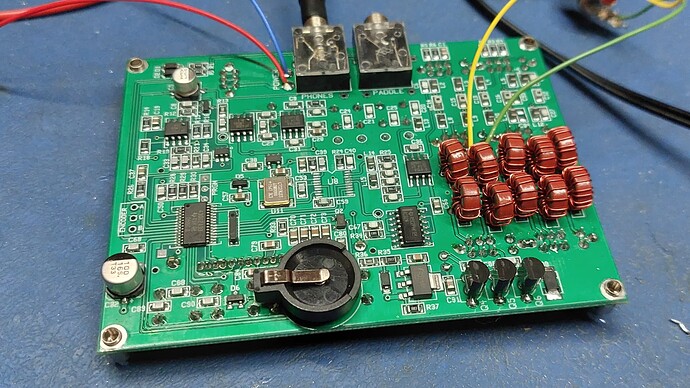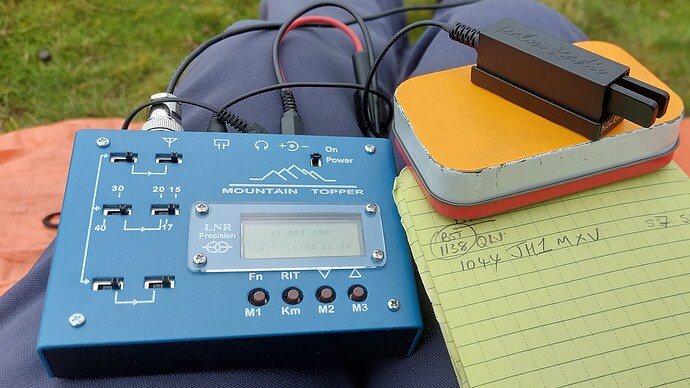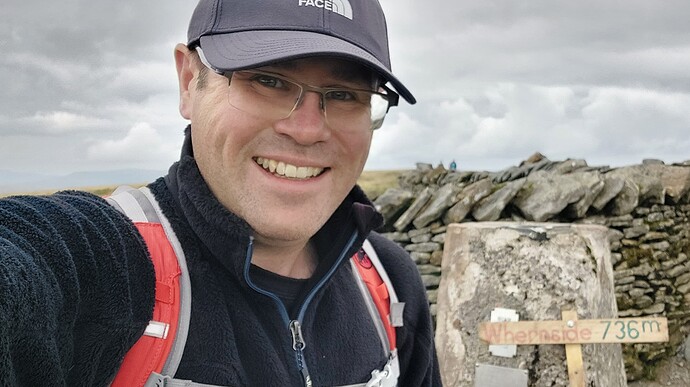A few weeks ago I was asked if I wanted a box of LNR Precision Mountain Topper parts. I’m not one to refuse free stuff!
The box arrived and it contained various MTR enclosures, along with wires, plugs, sockets, screws and a couple of PCBs. One of the PCBs was for an MTR-5B.
The MTR-5B PCB had lifted pads where the antenna connects to the board. I was able to scrape away some of the solder resist on the remaing tracks and attach some wires to the correct points. I applied power to the PCB and I tried keying the rig into my power meter/dummy load and discovered that there was no output. With a voltmeter I was able to establish that the PA stage was getting switched during keying and the voltages were correct. I concluded that the only possible causes were either a dead reference oscillator crystal or dead AD9834 DDS chip. I slept on it overnight. The following day, I decided that I’d be able to test my theory by digging out my oscilloscope from under the bench and looking at the outputs from the oscillator and DDS. The oscillator showed a healthy 60 MHz signal, but the DDS had no output. All the DDS inputs were proven to be correct, so the DDS device had to be at fault.
The AD9834 DDS is an SMT device in TSSOP24 package. I happened to have an AD9834 chip in my stores. I was too lazy to run a mains extension lead into my shack (my shack runs on solar with 300w inverter) so I wasn’t able to use my hot air nozzle. I simply flooded the TSSOP24 device with solder and nudged it off with tweezers. A quick clean with solder wick and acetone left the board ready for the replacement chip.
DDS chip (U8, centre) removed and PCB cleaned up.
Despite my ageing eyesight (recent eyetest confirmed that my near sight is showing signs of age related degeneration), I’m still able to solder SMTs with an iron and soon I had the replacement DDS chip fitted. Upon application of power (gingerly, via current limited bench supply!), I was pleased to see a healthy 10 MHz calibration signal on the output side of the DDS. Keying the board gave me about 3W at 9V - very good indeed.
Using my home brew GPS locked frequency counter I was able to calibrate the DDS calibration reference at exactly 10.000000 MHz. (2nd most useful piece of shack equipment next to 4SQRP QRPometer).
I did a full alignment of RX band filters, but to be honest, they were all pretty much OK already.
In the box of spare parts was a smart blue MTR-5B case, so I fitted a new CR1225 back up battery and fitted the PCB into the case. I bench tested the completed rig and declared it finished.
Today I had some spare time and I needed to put some steps on to my step counter after spending a lot of yesterday watching the funeral of Queen Elizabeth II on TV. I’ve activated Whernside G/NP-004 already this year but it’s one of my nearest summits and is the quickest in terms of time from home to summit. I packed the MTR-5B and left home for Whernside at around 1015am BST.
My intention was to try all five bands on the rig so I started on 15m. First in the log (and first QSO on the rig) was JH1MXV! I later worked 7N1FRE on 17m. 20m brought a contact with KG8P in Michigan. In total I managed 63 QSOs across 40/30/20/17 and 15m. Suffice to say that I think the rig is working OK. 
I think the MTR-5B is pleased to have given a second chance after being discarded on the reject pile!
I celebrated 25 years of amateur radio earlier this year and I still find it absolutely amazing that you can communicate with people almost 6000 miles away with a tiny device no bigger than your hand, powered by a battery no bigger than a chocolate bar.
73, Colin




 Same goes for DIL SA612, I think I’m sat on the world’s remaining stock!
Same goes for DIL SA612, I think I’m sat on the world’s remaining stock!